Neurons and Glia, Membrane Potential
1/61
There's no tags or description
Looks like no tags are added yet.
Name | Mastery | Learn | Test | Matching | Spaced |
|---|
No study sessions yet.
62 Terms
Neurons
Communication cells in nervous system. Single cell
Glia
Support cells. Have more glia than neurons
Nerve fiber
Axon (+ myelin sheath, if present)
Nerve
A bundle of axons bound together by connective tissue in the PNS
Ganglia
Group of neuronal cell bodies in the PNS
Sensory receptors are found
by the dendrites of the afferent neuron
Afferent neuron
Sensory, unipolar, towards CNS
Interneuron
In the spinal cord, multipolar
Efferent neuron
Motor, multipolar, away CNS
Most numerous neurons
Interneurons
All of the following general statements are true about neurons EXCEPT:
A. An individual neuron can receive
information from multiple other neurons.
B. An individual neuron can transmit
information to multiple other neurons
C. A given neuron can be either a
presynaptic neuron or a postsynaptic
neuron.
D. A neuron can simultaneously release
more than one type of neurotransmitter.
E. A neuron receives information on its
axons and delivers it to other neurons
through its dendrites.
E. A neuron receives information on its
axons and delivers it to other neurons
through its dendrites.
An interneuron synapses with an afferent
neuron. In this 2 neuron sequence, the
interneuron would be considered a:
D. Postsynaptic neuron
E. Presynaptic neuron
D. Postsynaptic neuron
What is the function of oligodendrocytes and Schwann cells?
They form the myelin sheath for axons.
Current
Movement of electrical charge
Electrogenic
A process by which net charge is transferred to a different location
Potential difference (volts)
Difference in the amount of charge between 2 point
Membrane potential
Potential difference across the membrane
Resistance
Opposition to the movement of an electrical charge
If the resting membrane potential for a cell
is -70 mV (generally it is between -5 and -100 mV), what does that mean?
C. The inside is negative compared to the
outside
D. The outside is negative compared to
the inside
C. The inside is negative compared to the
outside
Membrane potentials in cells are determined primarily by three factors
The activity of pumps (e.g., Na-K ATPase and Ca++ transport pumps) that maintain the ion concentrations across the membrane
The concentration of ions on the inside and outside of the cell
The permeability of the cell membrane to those ions (i.e., ion conductance) through specific ion channels
What is the movement of ions in the Na-K ATPase
2K+ in and 3Na+ out
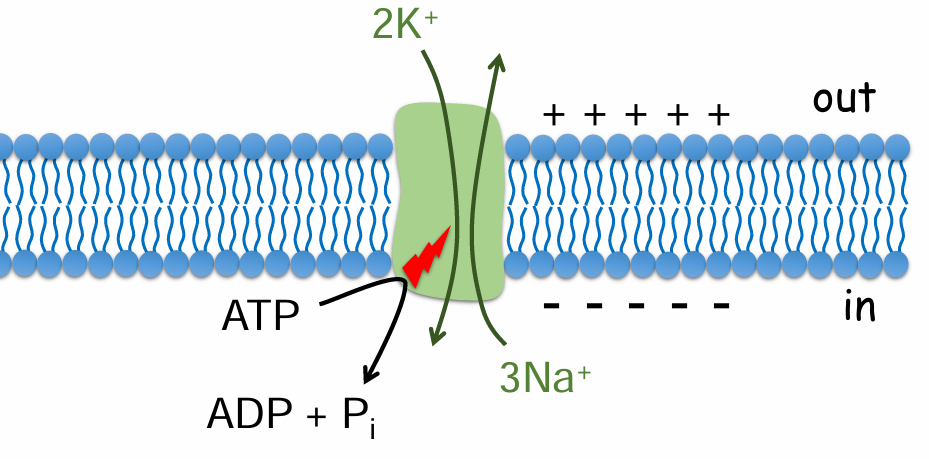
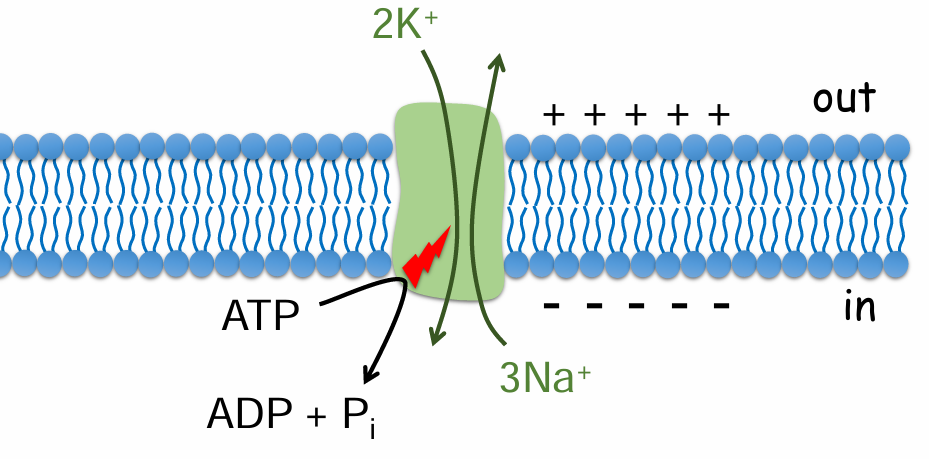
Is the Na-K ATPase electrically neutral or electrogenic?
Electrogenic
How much does the electrogenic nature of the Na-K ATPase contribute to the resting membrane potential (-70 mV)?
Only a small amount
What is the concentration of Na+ and K+ inside and outside the cell?
High Na+ outside and High K+ inside
What helps maintain these gradients for Na+ and K+?
Na-K ATPase
How can ions get across the plasma membrane?
Ligand-gated ion channels - Many
Voltage-gated ion channels - Many
Mechanical-gated ion channels - Not much
Leak channels
Closed when the membrane is at rest
At rest, the membrane is leaky, or somewhat permeable
K+
K+ leak channel, which is always
Open
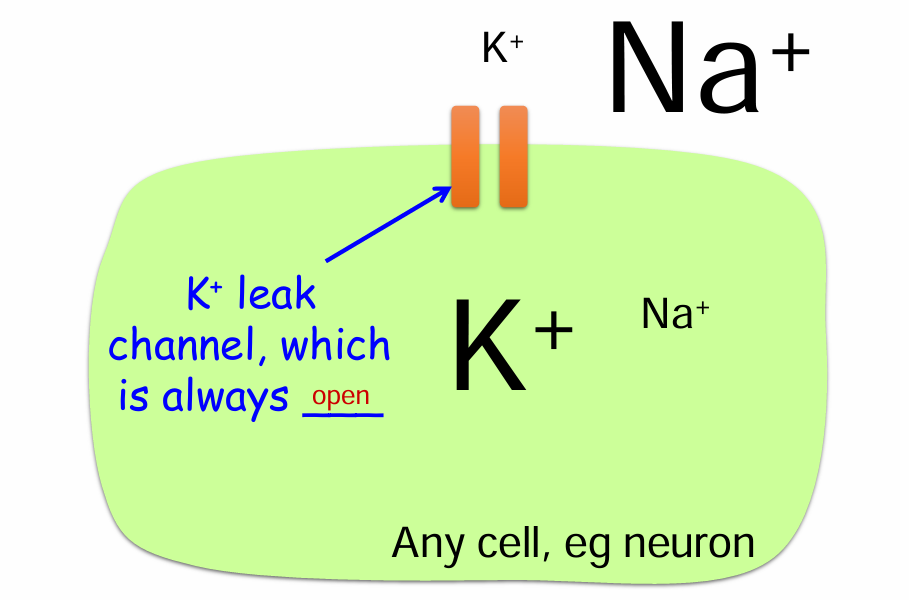
Can K+ go in either direction through the leak channel?
Yes, but the net movement depends on the driving force
Electrical gradient and concentration gradient
First driving force when K+ Channels are open
Concentration gradient of K+
K+ moves out of the cell
Generates a potential difference
Second and opposite driving force when K+ Channels are open
Potential difference created by the efflux of K+
K+ moves back into the cell
The potential charges of K+ inside and out
Negative inside, positive outside
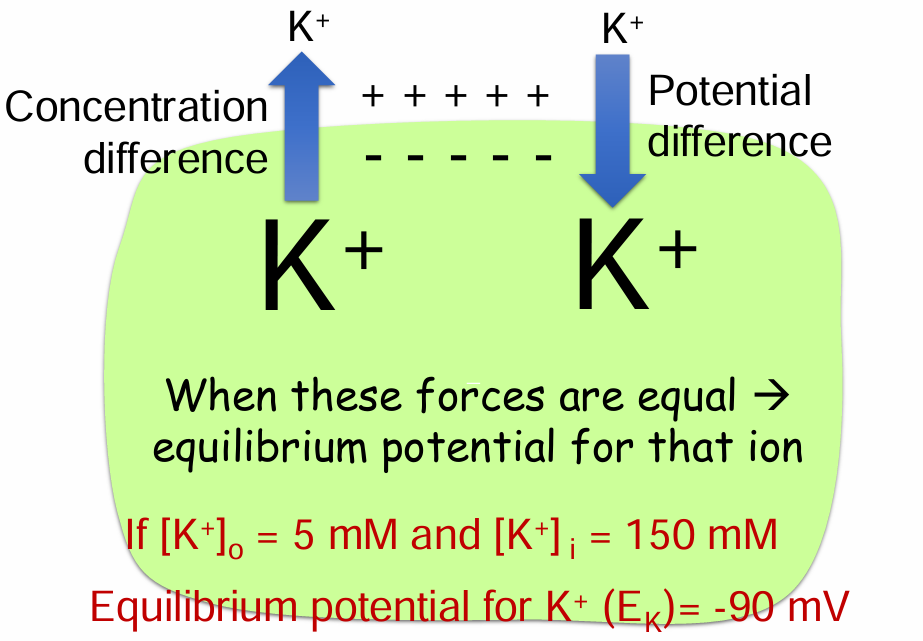
Equilibrium potential for K+ (EK)
-90 mV
How can we calculate the equilibrium potential for K+ (EK)?
Nernst equation
When the membrane is freely permeable to the ion
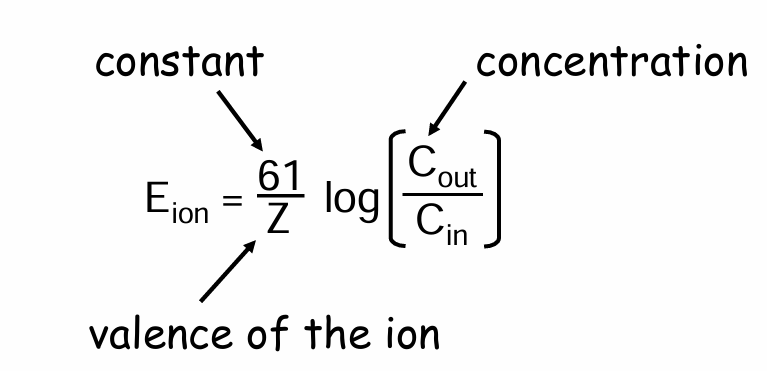
If the membrane is freely permeable to K+, at -90 mV, what happens to the movement of K+?
The amount of K+ exiting the cell due to the concentration gradient EQUALS The amount of K+ entering the cell due to the potential difference
If a neuron is permeable to K+ at rest, and the equilibrium potential for K+ is -90 mV, and the Na-K ATPase is electrogenic (makes the cell more negative), why is the resting membrane potential -70 mV instead of -90 mV, or even more negative?
The membrane is not freely permeable to K+ at rest
The membrane is very slightly permeable to Na+
Concentration gradient of Na+
Na+ moves inside of the cell
Potential difference of Na+
Na+ moves outside of the cell
The potential charges of Na+ inside and out
Positive inside, negative outside
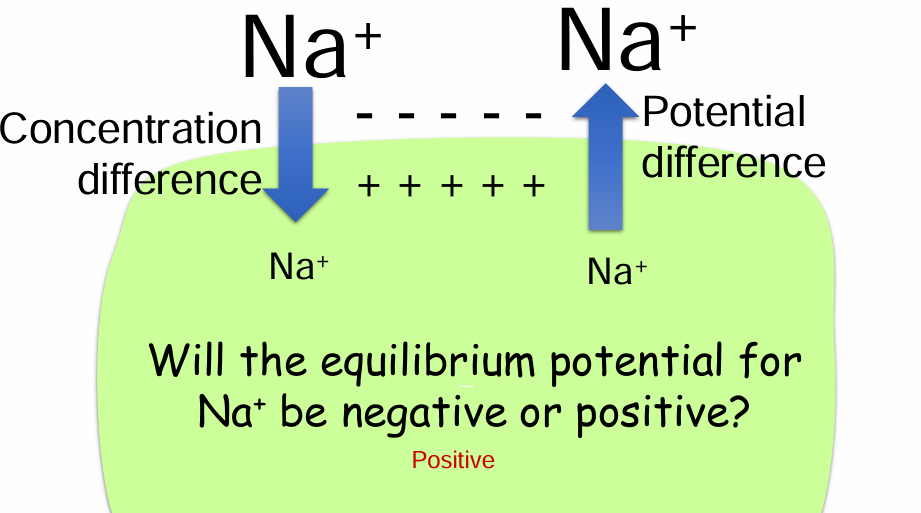
Equilibrium potential for Na+
+60 mV
So the resting membrane potential takes into account the movement of other ions besides K+. How can we calculate the resting membrane potential?
Use the Goldman-Hodgkin-Katz (GHK) equation. Out/ In
This takes into account the equilibrium potential for K+,
Na+ and Cl- along with their relative permeabilities
Chlorine in the The Goldman-Hodgkin-Katz (GHK) equation
Flipped because chloride is negative charge. In/ Out
There are other ions inside and outside the cell besides K+, Na+ and Cl-. Why is their contribution to the membrane potential zero?
At rest the membrane is impermeable to these other ions
If you suddenly raised the extracellular concentration of K+, what would that do to its equilibrium potential, and hence the membrane potential?
A. EK would be less negative than -90 mV
B. EK would be more negative than -90 mV
C. EK would not change
A. EK would be less negative than -90 mV
If you suddenly raised the extracellular concentration of K+, what would that do to its equilibrium potential? (More or less negative)
Less negative then -90 mV
Depolarize
membrane potential becomes more positive than resting membrane potential (RMP)
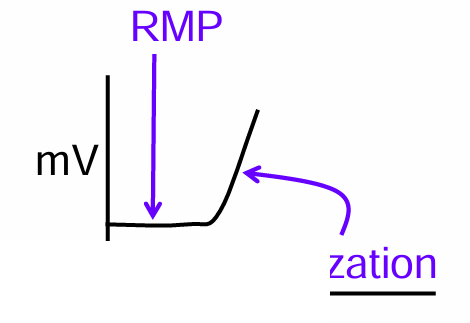
Hyperpolarize
membrane potential becomes more negative than the RMP
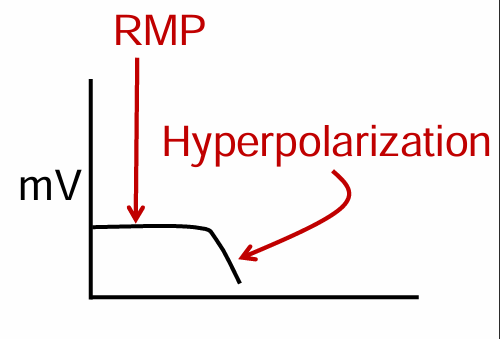
Does raising the extracellular concentration of K+ cause the membrane to depolarize or hyperpolarize?
Depolarize
What happens to the membrane potential if a gated Na+ channel opens?
A. Depolarize
B. Hyperpolarize
A. Depolarize
What happens to the membrane potential if a gated K+ channel opens?
A. There is no change in the membrane potential from rest
B. Depolarize
C. Hyperpolarize
C. Hyperpolarize
The membrane if more permeable to K+
GO from -70mV to -90mV
Hyperpolarize
What maintains the concentration of Na and K in and out of the cell
The Na-K ATPase
If the cell membrane is permeable to Cl- (i.e there are some open Cl- channels), and there is no Cl- pump, what happens to the chloride concentrations inside and outside the cell?
They adjust until the equilibrium potential for chloride (ECl) equals the resting membrane potential
If Cl- was pumped out of the cell causing a large concentration gradient for Cl- influx thereby making ECl negative to the resting membrane potential, would opening a Cl- channel cause hyperpolarization or depolarization?
A. Hyperpolarization
B. Depolarization
A. Hyperpolarization
Concentration gradient of Cl-
Cl- moves inside the cell
Potential difference of Cl-
Cl- moves outside the cell
The potential charges of Cl- inside and out
Negative inside, positive outside
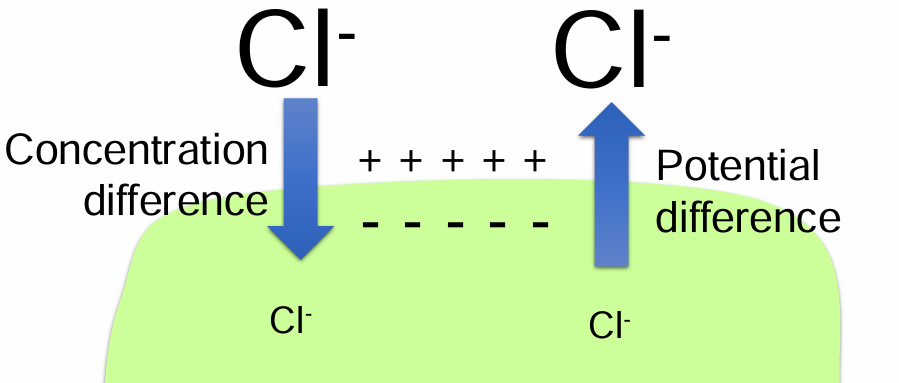
Is Cl- a depolarizing or hyperpolarizing current?
Hyperpolarizing
The [Ca++]o is 2 mM and [Ca++]i is 100 nM. The membrane at rest is impermeable to Ca++. If a Ca++ channel opens, does the membrane hyperpolarize or depolarize?
Depolarize
Concentration gradient of Ca++
Ca++ moves inside the cell
Potential difference of Ca++
Ca++ moves outside the cell
The potential charges of Ca++ inside and out
Positive inside, negative outside
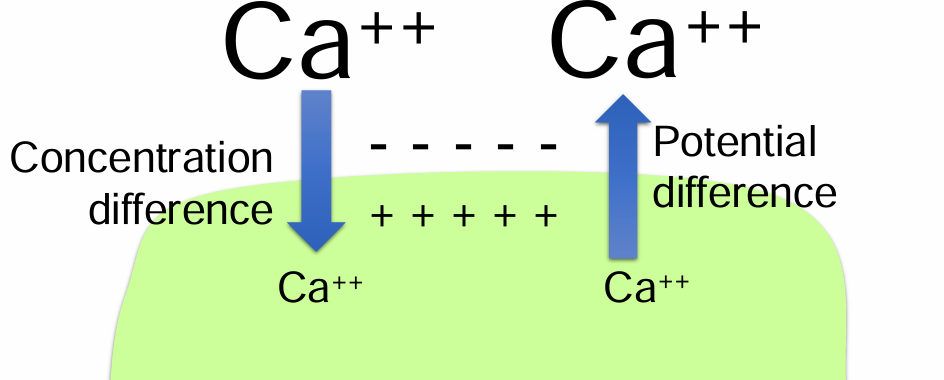
Is Ca++ a depolarizing or hyperpolarizing current?
Depolarizing